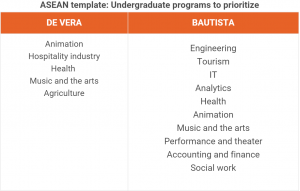Philippine colleges and universities have to make ‘hard decisions’ whether to increase graduate programs, or develop niches in the undergraduate programs in order to produce the manpower needed in the ASEAN region
Second of two parts
Part 1: School rankings in ASEAN: A ‘perception game’ for PH
MANILA, Philippines – If university rankings do not have much of an influence yet on policy-making in the Philippines’ higher education sector, how will the country use the numbers to its advantage?
For Philippine schools that want to make the most of the ASEAN integration, rankings can help in benchmarking with the universities in the region in order to identify which degree programs should be prioritized in quality assurance.
The Philippines’s premier state university, for example, has 5 competitive programs which already passed the quality assurance of the ASEAN University Network (AUN).
“There is an aggressive push in the AUN because of ASEAN integration to… benchmark with each other, so our position and our policies related to that are, of course, influenced by the rankings because we want more quality assurance,” University of the Philippines (UP) vice president for public affairs Prospero de Vera said in an interview.
The ASEAN framework
Quality assurance is important in the context of the integration, said Cynthia Bautista, a commissioner from the Commission on Higher Education (CHEd).
After 2015, there will be greater student and labor mobility in the region, so the education system of one country will inevitably be compared with its ASEAN neighbors. (READ: The road to ASEAN 2015: Why are PH colleges lagging behind?)
“We’re moving towards ASEAN, and the framework of education is lifelong learning, learner-centered, and people could just move in and out of the formal system. So increasingly, you’ll have more equivalencies, more pathways, and you’ll have to quality-assure,” Bautista said.
Quality assurance is part of the implementation of the ASEAN Qualification Reference Framework, which will enable comparison of qualifications of skilled labor across ASEAN member-states.
Bautista, who chairs the regional task force on the framework, said countries that are referenced in the ASEAN framework can no longer dismiss skilled labor from another ASEAN country for their qualifications.
“If we’re referenced in ASEAN framework, for instance, I cannot say no to you [a Filipino worker] if you’re applying to my company in Thailand – I cannot dismiss you for your qualification. But it’s possible for me not to consider you if I have other criteria apart from education,” she explained.
‘Winners’ in the ASEAN
With ASEAN integration just around the corner, de Vera said colleges and universities will now have to make “hard decisions” whether to rapidly increase their graduate programs in order to facilitate regional linkages.
“Kasi ‘pag pinalaki mo yung graduate program mo, malaki ang cost. You have to provide very good laboratories, your faculty must have PhDs, kasi kung wala, sinong makikipag-exchange sa iyo?”
(If you increase your graduate programs, the cost is high. You have to provide very good laboratories, your faculty must have PhDs, because if not, who will enter into exchanges with you?)
But not every university will go this route. For those schools, de Vera said the way to go is to look for niches – the “winners” in their undergraduate programs – and opportunities that exist in the ASEAN template in order to produce the manpower needed by the region.
“A career in agriculture may not be very enticing in the Philippines, but it doesn’t mean you will stop your agriculture programs. In fact, you just tweak it for your regional basis [because] you have countries that will need experts [in] agriculture,” de Vera noted.
Mainly professionals and skilled workers will be of high demand in the region, according to Bautista. (READ: 8 ways PH higher education can prepare for ASEAN 2015)

Bridging the gap
The harsh reality, however, is that many universities have yet to change their framework from a local mindset to an ASEAN one.
“Majority of the [state universities and colleges] will not be competitive in an ASEAN-integrated [era],” de Vera said.
Not all SUCs should necessarily be competitive anyway, but de Vera noted that the gap between UP – the country’s top university – and other schools shouldn’t be too wide as well, or the perceptions game will take its toll not only on our schools, but even on our college graduates.
“UP ranks, Ateneo ranks, [their graduates] get employed better… because of the perception that they’re better. They are ranked by companies that matter,” Bautista explained.
She added: “The perception, if you’re working outside [the country], is the rankings. Because of our low rankings, they look down on us. [You’re vulnerable] to exploitation because you either rank low or you don’t have enough years.”
But in the end, Philippine higher education institutions should consciously pursue better quality of education, regardless of rankings and whether they plan to internationalize or not.
Doing so will help ease the pains of a nation cramming education reforms just to catch up with its ASEAN neighbors. – Rappler.com